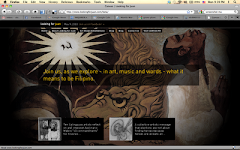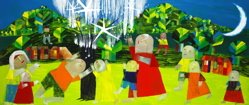Chanced upon this article from The Business Times in Singapore The next big thing?
 Ronald Ventura's 'Nesting Ground' (pictured above) sold for HK$2.18 million at Sotheby's in Hong Kong last year, a world record for Filipino Contemporary art at auctions. Is Filipino art set to fill the bubble that Chinese art exploded? By Woon Tai Ho
Ronald Ventura's 'Nesting Ground' (pictured above) sold for HK$2.18 million at Sotheby's in Hong Kong last year, a world record for Filipino Contemporary art at auctions. Is Filipino art set to fill the bubble that Chinese art exploded? By Woon Tai Ho
BLINK and you'll miss it. Tucked among shops along South Bridge Road selling handicraft to dried foods, Utterly Art is an obscure art space dedicated to an even more unlikely kind of art - its tiny 1,200 sq ft space houses the most Filipino art in the world outside the Philippines. Last year, gallery owner Pwee Keng Hock and his business partner Kenneth Tan had 18 shows just on Filipino art alone. This year, they are poised to end with 16 or 17 Filipino shows. A Randy Salon show earlier this year sold out, and their latest - for mid-career artist Jeho Bitancor - sold close to 70 per cent on opening day. Not bad, considering an economic downturn where art is said to be one of the first luxuries to go.
Utterly Art's finger on the pulse of the art market means it can act quickly to move in on any untapped niche. In this case, it was Filipino art - which was literally non-existent in Singapore then.
'A few galleries had sporadic features but no sustained and consistent presentations like what we do,' says Mr Pwee. But their strategy went beyond just that. With 200 exhibitions under their belt since they opened in 2001, the gallery has always shown an uncanny eye for unknown but talented artists, first in Singapore, and later in the region, before finally specialising in art from the Philippines.
By focusing on 'emerging' artists long before the word became popular, Utterly Art established itself as a venue for affordable and original art. 'Emerging artists need to start somewhere, and we happily became that somewhere,' adds Mr Pwee.
From 2006 to 2008, they rode out the 'art bubble', a period where Chinese and Indian contemporary art exploded - making millionaires out of poor artists, unsuspecting collectors, lucky galleries and happy auction houses. The bubble for Filipino art was tiny in comparison. Emerging Chinese artists' paintings right out of art school commanded prices of $20,000 to $30,000 each. But those were and still are the prices for established Filipino artists.
Mr Pwee and Mr Tan knew they were making a lot less money than those who concentrated on huge canvases from China and India, and later Indonesia. But they also knew the exploding market wasn't tenable. So when the bubble burst, Utterly Art was affected, but nowhere near the brutal blow big galleries had to bear.
In fact the bubble proved to be a blessing of sorts for Filipino art. Collectors, even galleries turned to cheaper art. Suddenly, work from the Philippines earned strong interest. Jay Amante, owner of two Blanc galleries in downtown Manila says: 'I see heightened interest from regional collectors in Filipino art, especially emerging contemporary artists. And this is mainly because of the quality and affordability of the works.' The economic downturn also 'benefited' Filipino artists who have always worked, even thrived, in the worst of economic conditions. Says artist Bitancor: 'We are used to making do with what is available.'
In the past year, the Filipino art scene has seen a boom, and for most of this year, when the general art market contracted, it held steady.
Sylvia Gascon, exhibit manager of Finale Arts File, a gallery in Makati, downtown Manila, says it is increasingly difficult to get art works from emerging contemporary artists in Manila, as they have been approached by regional and international galleries to hold exhibitions outside the country. As these artists take a long time to produce their works, the result is a shortage of 'supply' of readily available canvases.
'They have been able to maintain or even improve the range of their prices in auctions held by both Christie's and Sotheby's,' says Ms Gascon. 'But I must say this is not the case for the established masters such as Fernando Amorsolo and Fernando Zobel whose prices are already very high. Collectors are clearly looking out for contemporary artists, not the masters.'
Says Mark Justiniani, another respected contemporary Filipino artist: 'In fact, over the past 12 months, the art prices for contemporary artists have increased 20 to 30 per cent while the art prices in the other markets depreciated.' Jose Santos III, whose canvases are now much sought after, says with disbelief: 'There used to be a time when the Filipino artists could not even find a venue to show their works much less earn a living. The situation now is simply unimaginable.'
This economic downturn really has been a 'gift' to the Filipino art scene by showing how well its value is maintained. The Asian arts community sat up.
'It holds its own well, perhaps only second to the Chinese in technical skill. Their key emphasis is on figurative and representational art,' says Mr Pwee. 'Because of its great diversity, many different artists in all genres exist.'
The only Catholic nation in Asia, Filipino art is also characterised by Christian iconography and occasionally gives rise to what experts have described as 'dark, guilt-ridden images'.
Asked to single out the most striking feature of Filipino art, Justiniani sums it up thus: 'Non-prolific and individualistic, each artist strives to instill his or her own distinctive identity.'
Amante has only one word to describe Filipino art: 'diversity', and concedes that this economic crisis has been 'an ironic blessing of sorts for emerging artists in the Philippines'. He has been monitoring prices in both Christie's and Sotheby's. 'There is definitely heightened interest in contemporary Filipino art, allowing more artists into auctions and those that are already in auctions are maintaining their prices well.'
Keong Ruoh Ling of Christie's concurs: 'There are definitely more Filipino artists who have become suitable for our South-east Asian auctions. For those already in the auctions, they have maintained their prices, primarily because we have not seen dramatic increases in prices for Filipino artists compared to say the Chinese artists.'
Bitancor is cautious comparing Filipino art to those in Asia. 'We have yet to develop new media or multimedia to its full potential since it is technology-based and the Philippines has a lot to catch up with countries like Japan, Korea and others. We also are not capable of producing works that require sophisticated manufacturing.'
But for Filipino art lovers, like Khor Kim Huat who works in the media, and Sue Oliver who runs an advertising firm, they know the artists compensate with strong social messages. 'Most Filipino artists are not hungry for commercial success compared to many artists in China, India or Indonesia,' says Mr Khor. 'They thrive on addressing issues that are domestic with the use of available materials which are mostly organic. It lends character and sets them apart from high-tech art making.'
Ms Oliver, who recently purchased a piece by Filipino artist Crist Espiritu entitled Fast Food Funeral Party is fascinated by the symbolism used as social commentary. 'I am so amused by the expressions on the faces of friends who visit me - it certainly has shock value!'
Unlike other Asian countries, younger Filipino artists tend to be influenced by previous Filipino artists rather than foreign artists, so there is a distinct look and feel to Filipino art. Bitancor describes the look as crowding, or the fear of empty space. 'It is part of the Filipino psyche to put every last detail that the space may allow ... although artistic developments have revealed different approaches, thus a Filipino artist may now treat an empty space as positive.'
Some Filipino artists have already 'arrived', wildly collected by hungry enthusiasts. Geraldine Javier is an established name. And in a recent Sotheby's auction in Hong Kong, Ronald Ventura's Pinamumugaran (Nesting ground) sold for HK$2.18 million (S$390,000), setting a world record for any Filipino contemporary art at auctions. Two years ago, you could get his works for less than $10,000.
Roberta Dans, a Filipino based in Singapore who runs Artesan Gallery and Studio in Bukit Timah, is optimistic, saying that she enjoyed a 'profitable 2008'. She is proud to have had Ronald Ventura in residence and staged very successful exhibitions for the artist.
'Filipino art today is experiencing an explosive dialogue between the works of old masters, established artists and young emerging artists. Big opportunities are opening up to the truly talented artists who are successfully crossing borders and gaining international recognition. I do believe it is a very special era for Filipino art.'
Adds Mok Kim Chuan, who heads the South-east Asian Paintings Department at Sotheby's: 'When we compare the average prices of contemporary Filipino art that we have sold over the past few years, we do see a general indication that prices have increased.' And another sign worth noting for Filipino artists, says Mok is: 'The contemporary generation has progressively grabbed more headlines.'
But experts believe it would be difficult for Filipino art to reach 'success' in auction houses the way the Chinese, Indian and Indonesian artists have. 'Quality wise, certainly,' says Mr Pwee. 'But just based on population alone, there will always be more people looking for Chinese, Indian and even Indonesian art. Home-based support is crucial. I do see it developing into a regional South-east Asian power like Vietnam.'
Adds Santos: 'Auctions only reflect part of the whole picture. There are Filipino artists who are not visible in auctions but are having outstanding careers and very impressive artistic output.'
Still, the underlying sentiment is still that while the investment upside is important, collectors should buy art because they like it. The bonus, of course, is that if you play your cards right, what you like will grow in value right on your living room wall.
 Still on the issue of fault and accountability...
Still on the issue of fault and accountability...



















